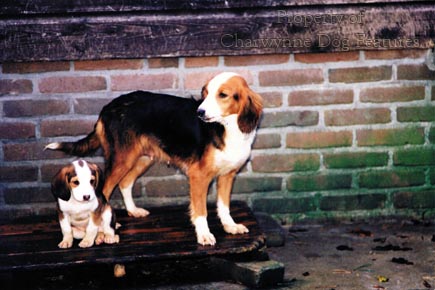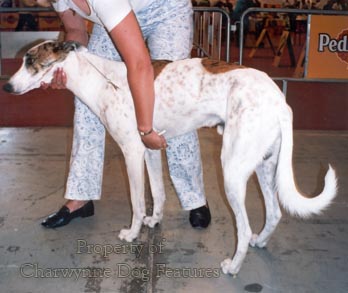617 Breeds Identity
BREED IDENTITY
by David Hancock
 When is a breed not a breed? Some might argue that to be truly a breed, then kennel club recognition somewhere in the world is a prerequisite. But this would deny us a rich array of terrier and hound breeds, which breed true to type and bear acceptable breed titles, but have never needed kennel club recognition. Fell Terriers and Harriers are more familiar names than Xoloitzcuintlis and Chinooks; the former have no kennel club recognition here, the latter two do have such recognition abroad and no doubt will soon feature here and seek it.
When is a breed not a breed? Some might argue that to be truly a breed, then kennel club recognition somewhere in the world is a prerequisite. But this would deny us a rich array of terrier and hound breeds, which breed true to type and bear acceptable breed titles, but have never needed kennel club recognition. Fell Terriers and Harriers are more familiar names than Xoloitzcuintlis and Chinooks; the former have no kennel club recognition here, the latter two do have such recognition abroad and no doubt will soon feature here and seek it.
Defining a breed with appropriate words is not entirely straightforward. My own working definition would be: a race of dogs that has been genetically isolated so that each member of that race resembles the others from the same breeding. I don't believe that kennel club recognition is essential for a breed to be regarded as a breed. Breeders of hunting packhounds in the world and sporting terriers here would probably support that view. Some countries have been very forthcoming in obtaining official recognition for their native breeds, the Swiss, for example, over their many hound breeds, all unknown here. But whilst there are six breeds of Dachshund, there is not, unlike the Belgian and Dutch shepherd dog, more than one breed of German Shepherd Dog.
Yet the old German breed displayed as many coat varieties as its western neighbours and possessed too a pure white sheepdog, as did so many other countries. A wire-haired, shaggy-haired, smooth-coated or whole white German Shepherd Dog might not get official approval nowadays, but the gene pool of the German herding dog included those varieties. Similarly there have been examples of rough-haired and long-haired, or Wheeler, Whippets, and, whilst many have alleged out-crosses to achieve these coats, the Whippet gene pool may well embrace them. 
There was uproar a few years ago when a mainly white Bullmastiff cropped up in an American pure-bred litter. There was concern too when piebald Mastiffs appeared both in Australia and America. There were allegations of a misalliance with an American Bulldog or even a St Bernard. But I cannot think why; mainly white Mastiffs were once quite common in Britain and that is where the genes come from. The distinguished vet and author Frank Townend Barton once found that his pure-bred Bloodhounds produced a whole white offspring, not an albino. He disposed of it and always regretted losing such genetic diversity. Throwbacks can be valuable breeding material.
Some distinguished breeds owe their existence to a gifted breeder who has worked to a plan and achieved his goal, such as Korthals with his Griffon pointer and the Martinez brothers with the Dogo Argentino. But I am wary of tiny gene pools. The Chinook is a sled dog breed derived from one outstanding dog. It demands great breeding skill to continue such a breed successfully. The Albanian Wolfhound on the other hand may never be a recognised breed and doesn't always breed true to type, but has all the virility of our lurchers. I do hope we do not lose the genes of the Dutch Steenbrak and the German Steinbracke, important features in the development of hound breeds in western Europe. 
This is one of the dilemmas in the world of dogs in the 21st century: do we value and perpetuate old breeds carrying valuable breeding material or let them fade away? Do we promote the recently developed Moscow Toy Terrier or insist on conserving the Iceland Farm Dog, which has survived centuries in a harsh environment? Do we ignore our native Harrier and patronise the Spanish Hound of a comparable type? Do we favour the Florida Cow Dog, now breeding to a set type, or the German Sauerland Hound of ancient lineage? Should we conserve the Austrian wire-haired Styrian Mountain Hound, which has proved its worth to man, or the long-haired 'sport' of the Chinese Shar Pei on display at a past Crufts?
Some breeds will undoubtedly disappear unless a group of determined fanciers come together and take charge. Even usually turgid-thinking kennel clubs have now accepted they have a role in this, especially where native breeds are concerned. The German Short-haired Pointer is a common sight at shows and in the field nowadays in Britain. But when working in Germany I have always been more impressed by the Langhaar and the Stichelhaar than the Kurzhaar. This was also true of the Small Munsterlander, which always impressed me more than the larger variety, but has never attracted British interest. Promoting a particular breed has often had a 'hit or miss' element to it.
Look at some of the KC-agreed breed histories if you doubt the credibility of my words! Comparable inventiveness has been responsible for the creation of some actual breeds. Are the Spanish Galgo and the Hungarian Magyar Agar really separate breeds from our Greyhound? Does the ear carriage difference between the Norwich and Norfolk Terriers justify their distinct classification as separate breeds?
Why does there have to be speculation over whether a dog rescued by British forces in Afghanistan is a Maremma or a Kangal Dog? Why can't it be an Afghan breed-type for which breed status has never been sought? Our own Victorian writers found difficulty in not regarding foreign breeds as having a quite separate development from ours. They even copied each other in debating whether our ancient water-dog, the Curly-coated Retriever, was a Poodle-Whiptail cross, and had little chance of understanding the origin of overseas breeds against that sort of ill-informed reasoning. And, to be fair to them, it is easy to think of the Irish Wheaten Terrier when you first see a Smoushond or an Irish Setter when you first see a Langhaar. But such similarities should serve to remind us that breeds developed from functions. Function often decided the type of coat, the stature, the head shape, the length of leg and therefore the appearance of the dog and the identity of the breed. Breed identity matters but not when origin is overplayed and breed history romanticised.